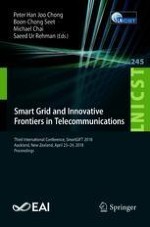2018 | Book
Smart Grid and Innovative Frontiers in Telecommunications
Third International Conference, SmartGIFT 2018, Auckland, New Zealand, April 23-24, 2018, Proceedings
Editors: Peter Han Joo Chong, Boon-Chong Seet, Dr. Michael Chai, Saeed Ur Rehman
Publisher: Springer International Publishing
Book Series : Lecture Notes of the Institute for Computer Sciences, Social Informatics and Telecommunications Engineering
